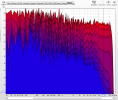Thank you.You could make your own quasi-anechoic measurements:

How to make quasi-anechoic speaker measurements/spinoramas with REW and VituixCAD
Quasi-anechoic measurements are a way to capture the 'real' frequency response of a speaker without the influence of a room. They are called 'quasi-anechoic' because they have the potential to get you really close to the results one might achieve with a non-reflective environment like an...www.audiosciencereview.com
Even if the speakers are flat on-axis, they might have a directivity error causing off-axis brightness.
You can use a calculator. It should only take a minute if you already know the dimensions of your room.

amroc - THE Room Mode Calculator
HTML5 room mode calculator. Read and hear the tune of axial, tangential and oblique modes. Scientific sources included.amcoustics.com
A short-term solution could be to limit the correction to below the transition frequency and apply a cutting shelf filter (or a low Q peak filter) to the treble to tame the brightness.
So you mean a cutting shelf filter outside of Audacity. I only have a graphic eq in the receiver outside of that. Or I don’t know how to do it.





